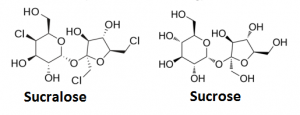Contents
Sucralose in the body
Sucralose is structurally similar to sucrose (table sugar), but it is chemically very different. The difference between sucralose and sucrose is that 3 hydroxyl groups from sucrose have been ‘swapped’ for chlorine molecules -this makes it a very different molecule with regards to biochemical interactions. You can see the image below that they do still look structurally similar though. This chemical change means that our bodies are unable to metabolise it and produce energy, making to zero calories, yet because it is still a similar shape to sucrose, sucralose will fit into the ‘sweet’ receptors on our tongue, which will cause us to taste sweetness.
Creation of Sucralose
Sucralose is thought to have been created accidentally, and, according to some the chemical was originally designed to be a pesticide, and was being developed at a Queen Elizabeth College, University of London. The aim of this research was to develop a pesticide based on the sugar molecule. During its development stages the team who were developing the product told a lecturer to ‘test it’ or ‘try it’. This was either misheard or misinterpreted by the lecturer to ‘taste it’ or try it as a food, and the lecturer found it to be very sweet tasting and started using it in his tea and coffee. The use of this chemical as an artificial sweetener sprouted from here. It sounds like a far fetched story I know, and I can’t find any evidence to support it (sadly).
Sucralose in the body
As with all unnatural molecules, our body cannot recognise them, and so struggles to metabolise them. This means that they can accumulate in our body which can disrupt various biological systems. With this in mind we should know how long they stay in our body, and know how they interact with various biological systems.
The majority of sucralose is not actually absorbed by the digestive system, but rather passes through our digestive system and out our body in our faeces. Only about 20% is absorbed into the blood and is ultimately passed out in our urine1. These findings are quite typical of foreign molecules, because our body doesn’t recognise them and struggles to transport them out of the digestive system (just as it struggles to metabolise them). With this in mind you would expect research to investigate how sucralose affects our digestive system, but this isn’t the case. There is only one study in rats which has investigated this, and it found that sucralose reduced the population of bifidobacteria and lactobacilli (two of the most well recognised probiotics)2. After a 12 week recovery period the lactobacilli population recovered, but thee bifidobacteria remained low. In addition to this the pH of the faces had been altered, suggesting a different environment in the digestive system. Human studies have not been conducted to confirm of disprove these findings as of yet, but these are concerning findings.
There is also concern that splenda can lead to nerve damage3, and it is associated with headaches 4 and other mild aliments which might result of over consumption of sucralose. With all of these claims and concerns, the research is weak, contradictory, and usually limited to animals such as rats, mice and in some cases dogs, but rarely in humans.
Current research and anecdotal evidence does show that sucralose is not very toxic, especially the short therm, and in small dosages every now and then. Sucralose has a half-life of about 18 hours1, which means if you eat 5mg of sucralose at 10am, and 4am you will have around 2.5mg of sucralose still inside you and so on. Concern arises when sucrolose is consumed to sweeten tea/ coffee throughout the day, every day. If you have 3 cups of tea/ coffee every day, all sweetened with sucralose, you will consuming more sucralose than you can excrete, causing it to accumulate which increases the risk of problems, and there is no research to address this concern.
Research bias and limitations
The current studies on sucralose have been quite small in scale, and limited in what they investigate. This already limited amount of research is further complicated by the involvement of Tate & Lyle (the company who manufacture Splenda) in much of the research projects conducted on sucralose, which, understandably, makes many people, suspicious of publication bias. (If you are not aware of the severity of publication bias have a read of this blog post about the AllTrials campaign). The pool of already limited research is now contaminated with the risk of publication bias – making reliable conclusions about the health effects of sucralose impossible. The studies on the safety of sucralose only ever last for a few weeks (rarely more than 12) which also is concerning, because we have no idea what the long term effects of sucralose accumulation will be.
Foods high in sucralose
If it is sweet and processed to some degree it will probably contain sucralose – you would be surprised when you begin to look at the list of ingredients. Here are some typical examples:
- Almost all fizzy drinks, especially zero or low calorie ones
- Protein bars
- Protein powders (if flavoured)
- Sweets
- Sweeteners for tea and coffee such as Splenda (obviously). Other sweeteners can also contain sucralose
- Pre-prepared deserts such as shop bought cheese cakes
- Ice-creams
Sucralose VS Sucrose – which is healthier?
The big question is, is sucralose healthier than sucrose? There is no clean cut answer, but my personal opinion is that it isn’t. Sugar is unhealthy, and is consumed in unhealthy quantities, but it still is a molecule which our body can recognise and metabolise easily. Too little is known about sucralose, so when in doubt, go as natural as possible (ideally none of either though!)
Summary
Sucrolose is one of many zero calorie sweeteners which are becoming popular in modern processed foods. It is an unnatural chemical, and how it behaves in our body is largely unknown. We do know that it is not toxic in small infrequent dosages, but regularly consuming sucralose over a large period of time may pose health risks. We have seen that it may be able to alter the microflora in our digestive system, and a number of other ailments have been attributed to sucrolose consumption, so if avoid it where possible.
References
1) A. Roberts, A.G. Renwick, J. Sims, D.J. Snodin. (2000). Sucralose metabolism and pharmacokinetics in man. Food and Chemical Toxicology. 38 (2), 31-41.
2) Abou-Donia MB, El-Masry EM, Abdel-Rahman AA, McLendon RE, Schiffman SS.. (2008). Splenda alters gut microflora and increases intestinal p-glycoprotein and cytochrome p-450 in male rats.. J Toxicol Environ Health A. 21 (n/a), 1415-29.
3) J.P Finn, G.H Lord. (2000). Neurotoxicity studies on sucralose and its hydrolysis products with special reference to histopathologic and ultrastructural changes. Food and Chemical Toxicology. 38 (2), 7-17.
4) Marcelo E. Bigal MD, PhD andAbouch V. Krymchantowski MD, PhD. (2006). Migraine Triggered by Sucralose—A Case Report. Headache. 46 (3), 515-517.


